April 2023
By Michael Crowley and Malcolm Dando
International treaties designed to prevent the weaponization of chemical and biological substances are not keeping up with modern science, and danger is lurking ahead.
Although the 1972 Biological Weapons Convention (BWC) and the 1993 Chemical Weapons Convention (CWC) were designed to be comprehensive in the substances encompassed and responsive to technological change, a regulatory gap risks both regimes failing to effectively prevent the development of toxin and bioregulator weapons now and in the future.
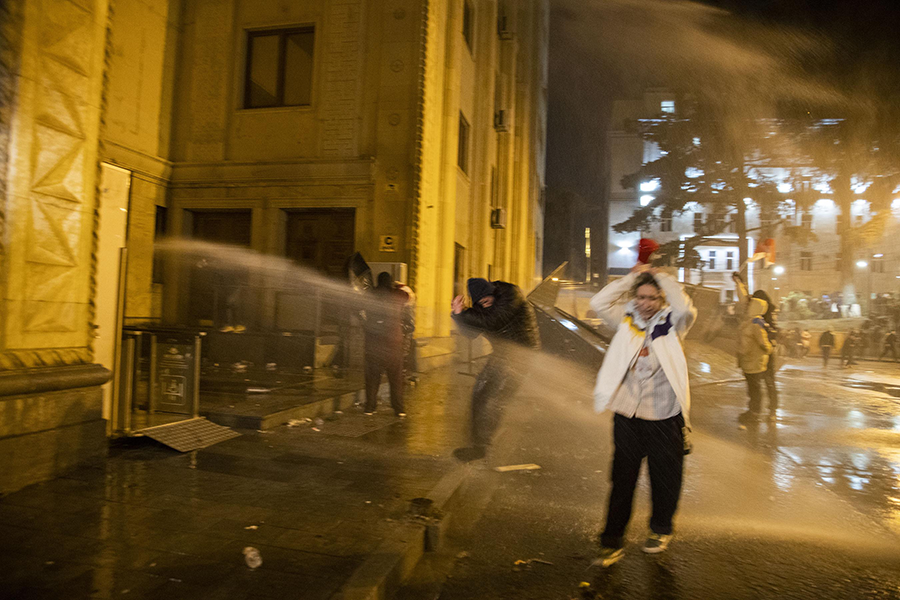 Recognizing that the store of potential future agents is essentially open-ended, both treaties are intended, inter alia, to cover and prevent the weaponization of toxins, bioregulators, and other substances of biological origin, as well as their synthetic analogues.1 The threat from the misuse of these potential agents continues to grow with advances in and the convergence of the chemical and life sciences and associated technologies. Because of long-standing textual ambiguities, however, exacerbated by inconsistencies and failures in implementation by states-parties, the apparent overlapping protection of the BWC and the CWC masks a dangerous regulatory gap.
Recognizing that the store of potential future agents is essentially open-ended, both treaties are intended, inter alia, to cover and prevent the weaponization of toxins, bioregulators, and other substances of biological origin, as well as their synthetic analogues.1 The threat from the misuse of these potential agents continues to grow with advances in and the convergence of the chemical and life sciences and associated technologies. Because of long-standing textual ambiguities, however, exacerbated by inconsistencies and failures in implementation by states-parties, the apparent overlapping protection of the BWC and the CWC masks a dangerous regulatory gap.
Julian Perry Robinson long recognized and warned of these failings:
Such overlap ought to mean, one might think, that the weapons are well controlled, being subject not just to one but to two international disarmament treaties. In the real world, however, that is not the way it is. That overlap seems simply to have given people involved in implementing one of the two treaties opportunity to relinquish responsibility for anything also covered by the other treaty. The area of overlap thus risks becoming a gulf into which things disappear. It looks like this has been happening to toxins.2
The fifth CWC review conference, scheduled for May in The Hague, has an explicit mandate to examine long-term issues of concern and to “take into account any relevant scientific and technological developments.”3 It is imperative that the 193 member states of the Organisation for the Prohibition of Chemical Weapons (OPCW), which implements the CWC, collectively recognize and address the significant and growing dangers from the potential malign application of the rapidly advancing chemical and life sciences. If they fail to do so, they risk eroding the OPCW’s capability to effectively prevent the emergence and proliferation of tomorrow’s chemical weapons.
Advancing Chemical and Life Sciences
The chemical, life, and associated sciences are undergoing a revolution in capabilities that is allowing scientists to understand and manipulate living systems in unprecedented ways. Although capable of producing immense societal and health benefits, these capabilities can be misused for malign purposes—the so-called dual-use problem. Of particular potential relevance are developments and convergences in neuroscience, medicinal chemistry, pharmacology, toxicology, immunology, molecular biology, systems biology, and synthetic biology, as well as their interactions with nanoscience, artificial intelligence research, and computer science.
Such overarching processes have significantly impacted and advanced the discovery and study of toxins and bioregulators, their mechanisms of action, the corresponding receptor and subreceptor sites with which they interact, and the broader functioning of the human brain, central nervous system, and other affected regulatory and physiological systems. These advances have occurred in parallel with the increasing ability to chemically synthesize peptide bioregulators and incorporate chemical modifications, resulting in analogues with markedly different physiological properties. Undeniably, this knowledge, and associated technological advances, will be a significant benefit, but given the multi-faceted applicability, it could instead be exploited in the development of toxin and bioregulator weapons or for other malign manipulation of core human physiological systems.
Dual-Use Research
One area of continuing concern has been the secrecy surrounding defense establishment research and associated activities related to toxins, bioregulators, bioregulatory pathways and physiological systems, and measures to facilitate agent dissemination and uptake. The necessity of such defense work is recognized and specifically permitted when it is conducted for “protective purposes” under the CWC or for “prophylactic, protection and other purposes” under the BWC. To increase confidence and prevent misperceptions, states are required to report on such work through annual CWC Article X declarations and are encouraged to submit similar details through the BWC confidence-building measures process. Unfortunately, public transparency in this area is insufficient to address disquiet surrounding the intentions and applications of such research and associated activities conducted by many national defense establishments.
For example, there have been decades-long concerns about institutions funded by or related to the U.S. military reportedly carrying out biological weapons-related research for “defensive purposes,” which has been perceived by certain states and civil society observers as coming dangerously near or actually crossing the line into offensive weapons research. Specific concerns have related to the apparent questionable U.S. interpretation that the BWC allows development of biological weapons when intended for “threat assessment” and the development of defensive countermeasures. A particular disquiet followed the 2004 establishment of the U.S. National Biological Threat Characterization Center with planned capabilities to investigate “aerosol dynamics, novel delivery of threat, novel packaging, simulation & modelling (epidemiology), genetic engineering, environmental stability, work on bioregulators and immunomodulators, genomics/proteomics [and] red teaming [i.e., duplication of threat scenarios].”4
Open-source information indicates that a range of contemporary toxin and bioregulator research of possible dual-use application has been carried out by the center and other U.S. military and military-related institutions and researchers. This has included investigation of staphylococcal superantigen functioning, production
of engineered nontoxic botulinum toxins through “rational design,” employment of recombinant technology to develop a nontoxic staphylococcal enterotoxin B mutant, and work on aerosolized ricin and botulinum toxin.
The United States has provided sufficient information or allowed publication of scientific papers on much of this research indicating their medical or protective purpose. Although the United States is far more open than many countries, given the lack of full public reporting and transparency for certain facilities and programs, it is not possible to determine the purpose of all such research or its potential application.
Novel Toxin Bio-threat Agents
Dual-use toxin research of potential concern extends far beyond previously investigated weapons agents. Military and nonmilitary institutions and scientists have searched out a growing range of “novel” toxins that could be weaponized, including those derived from indigenous poisonous plants, amphibians, reptiles, scorpions, and marine animals. In some cases, the stated intent and associated activities were clearly medical or for other protective purposes. In others, the intention was unstated or unclear; and in certain cases, the purpose appears explicitly to be toxin weaponization.
Scientists from the Indian Defence Research and Development Organisation (DRDO) and related bodies published a series of papers on their investigations of toxins derived from native Indian stinging and poisonous plants. In 2018 they argued that because the BWC “banned the use or stockpiling of most of the pathogenic bio-threat agents [this will] necessitate…search [for] some novel natural bio-threat agents from stinging plants that may be used as future bio-weapon[s] for self-defense purposes.” They consequently undertook a study to “identify, characterize and screen the potential of…stinging plants on the basis of their secondary metabolite contents that may be used for the formulation of novel future bio-threat agents for self-defense.”5
DRDO research continued into plants that produce “toxins that have the ability to adversely affect human health in a variety of ways, ranging from relatively mild allergic reactions to serious medical complications, including death.” They successfully identified several poisonous plants that can be used for the development of novel, multisystem, targeted warfare agents for defensive applications. They identified poisonous components from 10 plants and investigated their “mode of action,” which could “have harmful effect[s] on various biological systems like nervous, cardiac, digestive, respiratory, dermal, etc[.] simultaneously.”6 Some of the toxins investigated as potential agents, such as aconitine, are highly toxic and can be lethal. Others, although not as poisonous, potentially could be employed as “less lethal” toxin weapons.
Toxin Production
Concerns extend to large-scale production of potential weapons agents by certain states. Following its August 2013 chemical nerve agent attack on its own population, Syria was pressured to accede to the CWC and undertake an expedited chemical weapons disarmament process. On October 23, 2013, Syria declared its stockpile of chemical weapons and agreed to facilitate their verification and subsequent destruction under OPCW supervision. In its initial declaration, however, Syria failed to provide adequate information about its toxin-related activities. According to a press report, “Western officials with access to intelligence about Syria, [highlighted] topics of concern [including] deadly…agent ricin.”7
The United States and other CWC states-parties questioned the “accuracy and completeness of Syria’s declaration,” and in April 2014, the OPCW director-general established a Declaration Assessment Team “to attempt to resolve many of these concerns, including toxin-relevant activity.”8 Following the team’s work, Syria in 2014 amended its initial declaration. Subsequently, the OPCW director-general reported that Syria had declared “a facility for the production of ricin,” later identified as the Al-Maliha facility, as a “chemical weapons production facility.” He stated that “the newly declared facility is subject to verification and destruction.” According to Syria’s amendment, “the entire quantity of ricin produced was disposed of prior to the entry into force of the Convention for the Syrian Arab Republic.”9 In July 2018, the OPCW reported that its Technical Secretariat had verified the destruction of all Syrian declared chemical weapons production facilities, which included Al-Maliha.10
Despite this, there are still unresolved questions concerning Syria’s toxin production activities that reflect limitations in the OPCW reporting and verification system. First, if Syria had admitted its continued possession of a ricin stockpile after its accession to the CWC, it would have been required to declare all locations and quantities of such stockpiles and facilitate OPCW verification of its stockpile declaration through on-site visits and then verification of all stockpile destruction. Because Syria stated that it had destroyed its ricin stockpiles at some stage before accession, no such reporting and OPCW verification took place.
Second, Syria stated that its ricin production had been for medical purposes, such as cancer research and treatment. This assertion appears to conflict with Syria’s formal declaration of the facility to the OPCW as a chemical weapons production facility because this designation specifically excludes a “single small-scale facility for production of chemicals listed in Schedule 1 for purposes not prohibited under this Convention.”11 Clearly, this open question needs to be resolved. If the Al-Maliha ricin production facility was intended solely for medical or other civilian purposes, why did Syria not simply present proof to the OPCW and the public and continue with such important medical work?
At the time, Reuters reported skepticism regarding Syria’s reasons for not including the facility in its initial OPCW declaration. It quoted one unnamed diplomatic source as saying that “‘Syria will argue that the facilities were not revealed earlier because they were in a rush when they first had to report them…. They had said the ricin was for medical purposes, but we don’t believe that’s true.’”12 Given the previous, repeated obfuscation about its chemical weapons program, there is still legitimate concern as to whether Syria has been completely forthright about its activities at Al-Maliha and whether any further production facilities or stockpiles of ricin or other potential toxin weapons remain.
Brain Research Projects
In the last two decades, the technologies available to neuroscientists have developed rapidly and made it increasingly possible to understand the circuits in the central nervous system that underlie our behavior and the roles played by bioregulators in such processes. The obvious advantages of this work, for example in helping people with brain dysfunctions and injuries, has led states to initiate large-scale brain research projects. In certain countries, notably China, scientists at military medical institutions and other defense-related facilities are involved in much of the research. A number of research strands of the China Brain Project and related work of Chinese scientists on neurological systems and associated bioregulators, including noradrenaline, 5-HT, serotonin, and orexin, in a variety of simple animal models (fruit flies, zebrafish, and mice) have potential dual-use applicability.
To better understand more complex human behaviors and the mechanisms that produce them, large-scale work is also being carried out in China on the nervous system and responses of nonhuman primates, such as macaque monkeys. This has important dual-use implications because previous biological weaponeers did not restrict their work to manipulation of basic functions of the brain but also sought to influence human emotions, cognition, and consequent behavior. As noted in 2017,
this raises concerns about tacit capabilities…and the yoking of [nonhuman primate] studies and findings to military agendas under programs of dual- or direct-use…. Of particular note in such efforts is Junweikejiwei, the newly developed Chinese research agency that conjoins efforts of the [Chinese Academy of Sciences] and China’s Ministry of Defense, and which is modeled after the United States’ Defense Advanced Research Projects Agency, to engage rapid, high-risk/high-return approaches to bioscience and technology.13
It is certain that work within the China Brain Project includes studies of higher functions of the brain using advanced biotechnology with nonhuman primates as test subjects. One of China’s leading researchers highlighted the “goals of non-human primate research,” which included studies of the cognitive functions using nonhuman primates as the animal model and the generation of genetically modified, including transgenic, monkeys as animal models of human brain disorders and for basic neurobiology research. The research seeks to explore the neural basis of cognition, including how molecules and cells establish synaptic contacts and generate neural circuit activities.14 Although the purported purposes of such research are benign, there are risks of potential malign application, including to inform or facilitate development of bioregulator weapons to attack, subtly influence, or subvert human cognition.
‘Less Lethal’ Weapons
Concerns about the malign application of toxins, bioregulators, and other substances of biological origin, as well as their synthetic analogues, have extended to their development and use as so-called, often misnamed “less lethal weapons.” A particular focus of growing disquiet among many CWC states-parties, as well as medical and scientific bodies, has been development and use of weapons employing central nervous system-acting chemicals.
 These are a disparate group of toxic chemicals whose purported purpose as weapons is to cause prolonged but nonpermanent disability or incapacitation. They include centrally acting agents producing loss of consciousness, sedation, hallucination, incoherence, paralysis, and disorientation. Many putative agents have low safety margins, and inappropriate doses cause serious, sometimes permanent health effects, even death.
These are a disparate group of toxic chemicals whose purported purpose as weapons is to cause prolonged but nonpermanent disability or incapacitation. They include centrally acting agents producing loss of consciousness, sedation, hallucination, incoherence, paralysis, and disorientation. Many putative agents have low safety margins, and inappropriate doses cause serious, sometimes permanent health effects, even death.
The United States conducted long-term research into a range of potential central nervous system-acting chemicals, including pharmaceutical chemicals and bioregulators and related bioregulatory pathways, for law enforcement and military purposes on and off from the 1970s to the early 2000s. In addition to military- and law enforcement-funded projects intended to inform or facilitate potential development of such weapons, a wider range of potentially relevant dual-use research into related fields, such as brain research projects, has been funded in part by U.S. defense agencies. There is no evidence that any weapons employing central nervous system-acting chemicals were developed or fielded. In 2013 the United States unilaterally rejected the development, stockpiling, and use of this category of weapons and reconfirmed that position in November 2021.
The highly significant U.S. shutdown of such programs can be contrasted with the continuing worrisome activities of Russia. Until its collapse, the Soviet Union had undertaken research and attempted development of weapons employing central nervous system-acting chemicals, including pharmaceutical chemicals and bioregulators. According to high-level whistleblowers, during the 1980s at least, the Soviets explored potential bioregulator weapons in this category, investigating endorphins, enkephalins, and other neuromodulating peptides potentially capable of altering human cognition and emotions. One whistleblower alleged that “the mood-altering possibilities of regulatory peptides were of particular interest to the KGB.” Although no evidence of development or use of bioregulator weapons has been found, it is unclear whether all such activities terminated following the change in political system in Russia.
In 2002, Russian security forces employed an aerosolized central nervous system-acting pharmaceutical chemical weapon in a large-scale anti-terrorist operation to rescue more than 900 hostages held in a Moscow theater. Although most hostages were freed, more than 120 of them were killed by the chemical agent, and many more continue to suffer long-term health problems. Since then, Russian dual-use research into pharmaceutical chemicals with potential central nervous system weapons application has been reported. Russia stated that law enforcement use of such weapons is not regulated by the CWC. It rejected the legitimacy of the 2021 CWC conference of state-parties “understanding” that law enforcement use of aerosolized versions of these chemicals was prohibited under the convention.
Riot control agents are defined under the CWC as chemicals not listed in one of the treaty schedules, which rapidly produce sensory irritation or disabling physical effects that disappear within a short time following termination of exposure. In addition to chemically synthesized chemicals, these agents include a number of substances of biological origin, notably capsaicinoids. The CWC prohibits the use of riot control agents as a method of warfare, but permits their use for “law enforcement including domestic riot control purposes,” provided they are used in “types and quantities” consistent with such purposes.
Riot control agents have been frequently misused for serious human rights violations, most commonly in noncustodial settings to restrict, intimidate, and punish public protesters worldwide and in the prisons, detention centers, and police stations of certain countries to mistreat individuals.15 A recurring medical concern has been their use in excessive quantities in the open air or in confined spaces where the targeted individuals cannot disperse. In such situations, serious injury or death can result, including from the toxic properties of the chemical agents or asphyxiation.16
This situation could dramatically worsen as development, marketing, and deployment of systems capable of delivering significant amounts of riot control agents over wide areas or extended distances intensifies. In addition to potential misuse for collective mistreatment or punishment of crowds, such wide-area riot control agent delivery mechanisms could be employed as force multipliers in conjunction with firearms, making lethal force more deadly on a large scale. Although nominally developed for law enforcement, they also may be incorporated into military arsenals in the future and used in armed conflict in contravention of the CWC and, in the case of capsaicinoids, the BWC.
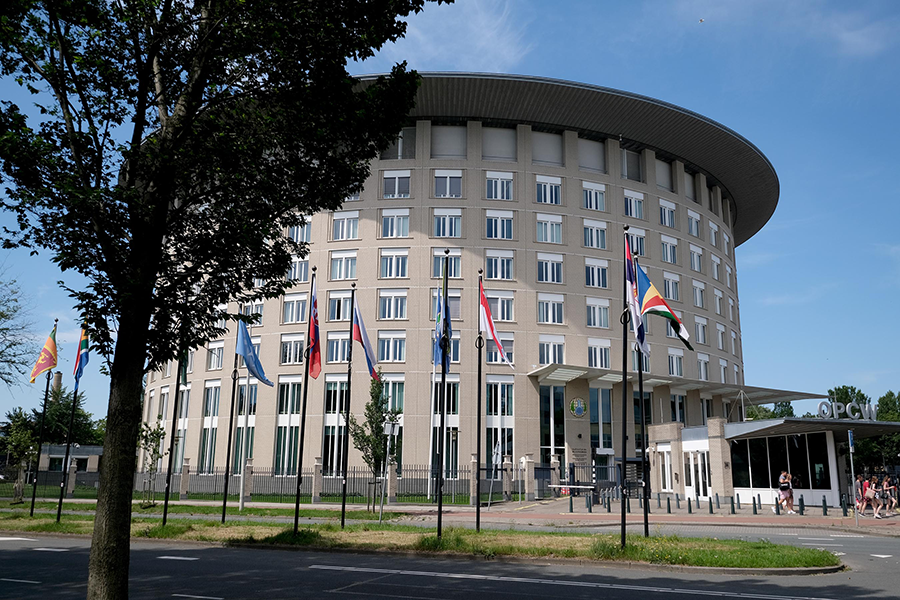 The OPCW Scientific Advisory Board in its February 2023 report for the forthcoming review conference has voiced concerns over the “continued development, testing, production, and promotion of diverse” wide-area riot control agent delivery mechanisms. It warned that “the capabilities being developed increasingly resemble military equipment. These systems could be repurposed and filled with other chemicals,” including chemical warfare agents, central nervous system-acting chemicals, and bioregulators.17
The OPCW Scientific Advisory Board in its February 2023 report for the forthcoming review conference has voiced concerns over the “continued development, testing, production, and promotion of diverse” wide-area riot control agent delivery mechanisms. It warned that “the capabilities being developed increasingly resemble military equipment. These systems could be repurposed and filled with other chemicals,” including chemical warfare agents, central nervous system-acting chemicals, and bioregulators.17
Civil society researchers have documented development and promotion of wide-area riot control agent delivery mechanisms, including indoor dispersion devices, water cannons, external area denial devices, multibarrel projectile launchers, large-caliber projectiles, and delivery mechanisms mounted on remote weapons systems, unmanned ground vehicles, and drones.18 Widespread deployment has not been documented, but the world may now be at a tipping point where proliferation, use, and misuse may be beginning.
Challenges for Today and Tomorrow
Perceptions of the potential threats from or uses of toxin and bioregulator weapons will be influenced by the unique and evolving international, regional, and national security environment that each state faces. Such considerations are complicated where the borders may blur, shifting between large and small international and noninternational armed conflicts, large-scale human rights violations, revolutions and uprisings, insurgencies, terrorism, and organized crime. Of obvious concern would be potential state interest in perceived military utility and consequent development and acquisition of toxin and bioregulator weapons with wide-area battlefield effects causing mass fatalities and casualties through severe disruption of the central nervous system and other core bodily functions.
Alternatively, state militaries may be attracted to “less lethal” forms of such weapons that cause unconsciousness, immobilization, or other temporary incapacitation or that more subtly alter the perception, emotions, and behavior of opposing combatants. In addition to their use in full-scale armed conflict, military forces could employ toxin or bioregulator weapons in other scenarios of potential or actual combat such as peacekeeping, peace enforcement, counterinsurgency, or counterterrorism operations, particularly where civilians and combatants are mixed.
Police and security forces, in addition to continued use of existing riot control agents, may in the future be tempted to utilize toxins and bioregulators for domestic law enforcement to manipulate or punish protesting crowds or for other large-scale policing of public assemblies. In custodial situations, certain toxins and bioregulators could make prisoners compliant and trusting, while alternative agents could cause discomfort, pain, or illness; induce depression or anxiety; and so be employed in torture. Certain state intelligence and internal security forces, such as the Soviet Union, previously attempted to develop bioregulator and toxin weapons for use in espionage operations, including covert assassinations. It seems plausible that such activities will continue, potentially for use against their own citizens and targets in third countries.
Building on the existing capabilities of the chemical, life, and associated sciences and postulating potential research trajectories, it can be imagined how the malign application of future developments, if insufficiently regulated, could enable states to chemically manipulate and subjugate large swaths of their own or foreign populations. Although such repressive capabilities are speculative now, the world’s rapidly increasing knowledge of and ability to manipulate the body’s bioregulatory pathways, coupled with advances in wide-area agent dissemination, mean that such threats are likely to increase in the coming years if not addressed now.
The BWC and CWC were primarily intended to prevent and address the development and use of biological and chemical weapons in armed conflict and to facilitate the destruction of all extant weapons production capacity and stockpiles. There are serious questions about whether these conventions and the associated control regimes can respond adequately to the diverse and potentially malign applications of the chemical and life sciences on the battlefield and beyond. The CWC review conference beginning May 15 will be an important indicator about whether that treaty can meet the challenges of today and tomorrow.
ENDNOTES
1. Toxins can be considered to be toxic, or poisonous, material of natural origin and their synthetic analogues or derivatives that can cause death, permanent harm, or temporary incapacitation. Bioregulators are naturally occurring chemicals produced within living organisms that normally help to ensure the proper functioning of vital physiological systems in those same organisms. If present in or introduced into the body in excessively large amounts, these benign chemical messengers will produce extremely devasting toxic effects, becoming highly potent de facto toxins.
2. Julian Perry Robinson, “Bringing the CBW Conventions Closer Together,” The CBW Conventions Bulletin, No. 80 (September 2008), p. 2, http://www.sussex.ac.uk/Units/spru/hsp/documents/cbwcb80.pdf.
3. Convention on the Prohibition of the Development, Production, Stockpiling and Use of Chemical Weapons and on Their Destruction, art. VIII, para. 22, January 13, 1993, 1974 U.N.T.S. 45 (hereinafter CWC).
4. Lt. Col. George Korch, “Leading Edge of Biodefense: The National Biodefense Analysis and Countermeasures Center,” n.d., slide 12, https://biosecurity.fas.org/resource/documents/nbacc%20ppt.pdf (presentation, U.S. Department of Defense Pest Management Workshop, Jacksonville, Florida, February 2004).
5. Sanjay Mohan Gupta, Kamal Kumar, and Rakshit Pathak, “Phytochemical Analysis of Indian Stinging Plants: An Initiative Towards Development of Future Novel Biothreat Agents for Self-Defence,” Proceedings of the National Academy of Sciences, India Section B: Biological Sciences, Vol. 88, No. 2 (2018): 819–825.
6. Sanjay Mohan Gupta et al., “Himalayan Toxic Plants of Defense Importance,” ACTA Scientific Medical Sciences, Vol. 2, No. 3 (June 2018): 44–48.
7. Louis Charbonneau, “Western Intel Suggests Syria Can Still Produce Chemical Arms,” Reuters, April 25, 2014.
8. Bureau of Arms Control, Verification and Compliance, U.S. Department of State, “2015 Report on Adherence to and Compliance With Arms Control, Nonproliferation, and Disarmament Agreements and Commitments,” June 5, 2015, https://2009-2017.state.gov/t/avc/rls/rpt/2015/243224.htm#Syria.
9. Organisation for the Prohibition of Chemical Weapons (OPCW) Executive Council, “Note by the Director-General: Progress in the Elimination of the Syrian Chemical Weapons Programme,” ECM44/DG.1, July 25, 2014, para. 4(b).
10. OPCW Executive Council, “Note by the Director-General: Progress in the Elimination of the Syrian Chemical Weapons Programme,” EC-89/DG.1, July 24, 2018.
11. CWC, art. II, para. 8(b)(iii).
12. Anthony Deutsch, “Exclusive: Syria Reveals More Chemical Weapons Facilities to Watchdog - Sources,” Reuters, September 17, 2014.
13. Guillermo Palchik, Celeste Chen, and James Giordano, “Monkey Business? Development, Influence, and Ethics of Potentially Dual-Use Brain Science on the World Stage,” Neuroethics, Vol. 11, No. 2 (February 2017): 111–114.
14. Mu-ming Poo, “China Brain Project and Non-human Primate Research in China” (Presentation, The Brain Forum, Lausanne, 2016), slide 11, https://thebrainforum.org/downloads/Presentations-2015-and-2016/China-Brain-Project-and-non-human-primate-research-Prof-Mu-ming-Poo.pdf.
15. For illustrative cases, see Amnesty International, “Tear Gas: An Investigation,” n.d., https://teargas.amnesty.org/#top (accessed March 18, 2023); Michael Crowley, Chemical Control: Regulation of Incapacitating Chemical Agent Weapons, Riot Control Agents and Their Means of Delivery (London: Palgrave Macmillan, 2016), pp. 50–80.
16. See Amnesty International, “Tear Gas: An Investigation,” n.d., https://teargas.amnesty.org/#top (accessed March 18, 2023); Michael Crowley, Chemical Control: Regulation of Incapacitating Chemical Agent Weapons, Riot Control Agents and Their Means of Delivery (London: Palgrave Macmillan, 2016), pp. 48–49 and pp. 72–75.
17. OPCW Review Conference, “Report by the Director-General: Report of the Scientific Advisory Board on Developments in Science and Technology to the Fifth Special Session of the Conference of the States Parties to Review the Operation of the Chemical Weapons Convention,” RC-5/DG.1, February 22, 2023, para. 80
18. Crowley, Chemical Control; Michael Crowley, Tear Gassing by Remote Control, Remote Control Project/Bradford University/Omega Research Foundation, December 2015.
Michael Crowley is an honorary visiting senior research fellow at Bradford University and research associate with the Omega Research Foundation. Malcolm Dando is a fellow of the Royal Society of Biology in the United Kingdom and Leverhulme Emeritus Fellow at Bradford University. This article is drawn in part from the authors’ recent book: Toxin and Bioregulator Weapons: Preventing the Misuse of the Chemical and Life Sciences, Palgrave Macmillan, 2022.
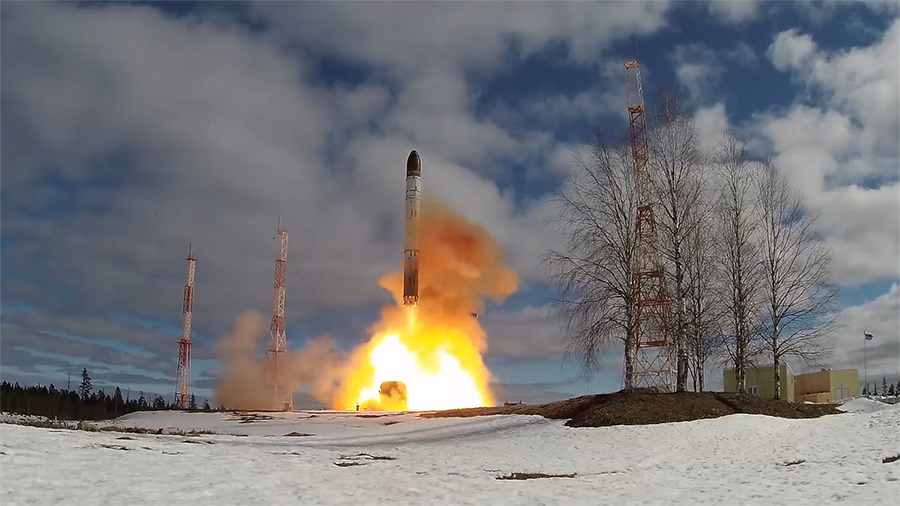 Because there are no winners in a nuclear war or a costly nuclear arms race, leaders in Washington, the leading non-nuclear-weapon states, and concerned people everywhere need to press these states, as well as France and the United Kingdom, to exercise restraint and engage in disarmament diplomacy.
Because there are no winners in a nuclear war or a costly nuclear arms race, leaders in Washington, the leading non-nuclear-weapon states, and concerned people everywhere need to press these states, as well as France and the United Kingdom, to exercise restraint and engage in disarmament diplomacy.





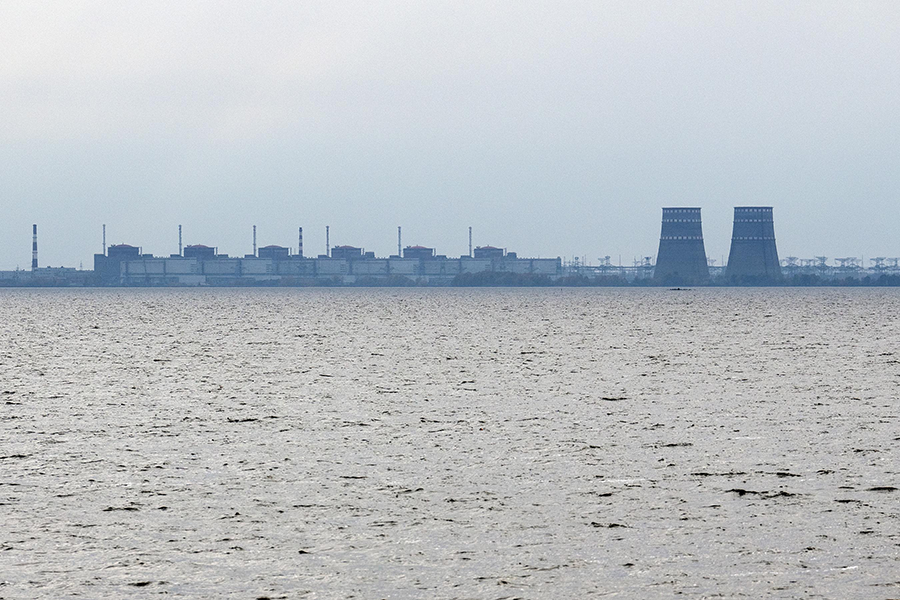 The trip had been painstakingly negotiated over the summer months, with approvals needed from Ukrainian and Russian government officials. Finally, with an agreement in place, IAEA Director-General Rafael Mariano Grossi and his team of 14 safety, security, and safeguards experts were on the way to the beleaguered plant. By September 1, they had made it to the final checkpoint, just a few hundred meters from their destination, but were blocked from entering the facility. With bombings in the vicinity, the team refused to back down and eventually was allowed to enter. It was an inauspicious start to one of the most important missions in recent IAEA history.
The trip had been painstakingly negotiated over the summer months, with approvals needed from Ukrainian and Russian government officials. Finally, with an agreement in place, IAEA Director-General Rafael Mariano Grossi and his team of 14 safety, security, and safeguards experts were on the way to the beleaguered plant. By September 1, they had made it to the final checkpoint, just a few hundred meters from their destination, but were blocked from entering the facility. With bombings in the vicinity, the team refused to back down and eventually was allowed to enter. It was an inauspicious start to one of the most important missions in recent IAEA history.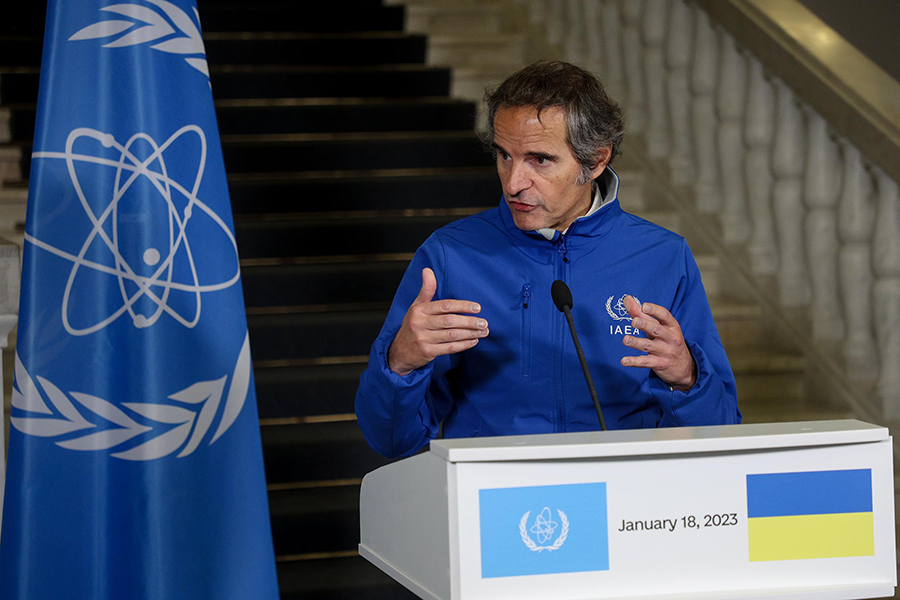 To monitor the situation at nuclear sites in Ukraine with regard to these pillars, the IAEA has stationed a permanent presence at Zaporizhzhia since the initial site visit in September. This monitoring team initially included two experts focused on nuclear safety and security and has been expanded to four experts in recent months to cover additional topics, such as safeguards. This group provides much needed, unbiased information about what is taking place at the site. The experts also provide regular updates via the IAEA website. In early 2023, the IAEA deployed permanent missions to the other nuclear facilities in Ukraine: Khmelnytsky nuclear power plant, Rivne nuclear power plant, South Ukraine nuclear power plant, and Chernobyl. With these additional teams in place, the IAEA will have at least 11 nuclear safety and security experts in Ukraine at any given time.
To monitor the situation at nuclear sites in Ukraine with regard to these pillars, the IAEA has stationed a permanent presence at Zaporizhzhia since the initial site visit in September. This monitoring team initially included two experts focused on nuclear safety and security and has been expanded to four experts in recent months to cover additional topics, such as safeguards. This group provides much needed, unbiased information about what is taking place at the site. The experts also provide regular updates via the IAEA website. In early 2023, the IAEA deployed permanent missions to the other nuclear facilities in Ukraine: Khmelnytsky nuclear power plant, Rivne nuclear power plant, South Ukraine nuclear power plant, and Chernobyl. With these additional teams in place, the IAEA will have at least 11 nuclear safety and security experts in Ukraine at any given time.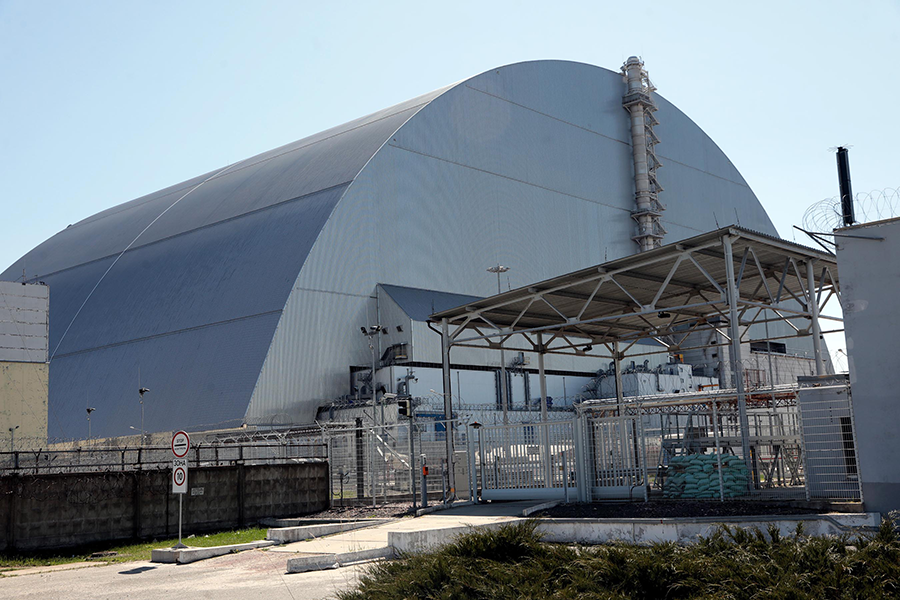 As like-minded states seek to roll back climate change and reach zero carbon emissions in the next few decades, nuclear power could play an important role in the overall mix of energy sources to achieve that goal. If a significant nuclear incident occurs at Zaporizhzhia or elsewhere in Ukraine or during the next conflict, it could have a major chilling effect on global interest in expanding nuclear energy. That was the reaction in the wake of other serious nuclear incidents, including Chernobyl, Fukushima, and Three Mile Island, which all led to unintended release of radioactive particles. As a result, the world turned away from nuclear power for a time in favor of other, less climate-friendly sources. Given the enormous challenges of climate change, another such disaster could have significant long-term impacts that go well beyond the specific environmental impacts from the nuclear incident itself.
As like-minded states seek to roll back climate change and reach zero carbon emissions in the next few decades, nuclear power could play an important role in the overall mix of energy sources to achieve that goal. If a significant nuclear incident occurs at Zaporizhzhia or elsewhere in Ukraine or during the next conflict, it could have a major chilling effect on global interest in expanding nuclear energy. That was the reaction in the wake of other serious nuclear incidents, including Chernobyl, Fukushima, and Three Mile Island, which all led to unintended release of radioactive particles. As a result, the world turned away from nuclear power for a time in favor of other, less climate-friendly sources. Given the enormous challenges of climate change, another such disaster could have significant long-term impacts that go well beyond the specific environmental impacts from the nuclear incident itself. Recognizing that the store of potential future agents is essentially open-ended, both treaties are intended, inter alia, to cover and prevent the weaponization of toxins, bioregulators, and other substances of biological origin, as well as their synthetic analogues.
Recognizing that the store of potential future agents is essentially open-ended, both treaties are intended, inter alia, to cover and prevent the weaponization of toxins, bioregulators, and other substances of biological origin, as well as their synthetic analogues. These are a disparate group of toxic chemicals whose purported purpose as weapons is to cause prolonged but nonpermanent disability or incapacitation. They include centrally acting agents producing loss of consciousness, sedation, hallucination, incoherence, paralysis, and disorientation. Many putative agents have low safety margins, and inappropriate doses cause serious, sometimes permanent health effects, even death.
These are a disparate group of toxic chemicals whose purported purpose as weapons is to cause prolonged but nonpermanent disability or incapacitation. They include centrally acting agents producing loss of consciousness, sedation, hallucination, incoherence, paralysis, and disorientation. Many putative agents have low safety margins, and inappropriate doses cause serious, sometimes permanent health effects, even death. The OPCW Scientific Advisory Board in its February 2023 report for the forthcoming review conference has voiced concerns over the “continued development, testing, production, and promotion of diverse” wide-area riot control agent delivery mechanisms. It warned that “the capabilities being developed increasingly resemble military equipment. These systems could be repurposed and filled with other chemicals,” including chemical warfare agents, central nervous system-acting chemicals, and bioregulators.
The OPCW Scientific Advisory Board in its February 2023 report for the forthcoming review conference has voiced concerns over the “continued development, testing, production, and promotion of diverse” wide-area riot control agent delivery mechanisms. It warned that “the capabilities being developed increasingly resemble military equipment. These systems could be repurposed and filled with other chemicals,” including chemical warfare agents, central nervous system-acting chemicals, and bioregulators.![Joseph Manso, U. S. ambassador to the Organisation for the Prohibition of Chemical Weapons, says that “a violator of the norm against chemical weapons [such as Syria] will not be treated as a normal country.” (Photo: OPCW)](/sites/default/files/images/ACT_Photos/2023_04/07_ACT_April2023_Interview_Manso.png) Delegates to the fifth review conference of the Chemical Weapons Convention (CWC) will convene in The Hague on May 15 with two markers on their scoresheet. One is positive: the United States is on track to complete the destruction of its chemical weapons stockpile in September, in line with its CWC obligations. The other is ominous: two CWC states are known violators of the 26-year-old convention, which outlaws the development, production, and use of deadly chemical weapons and requires the verifiable destruction of remaining stockpiles. As the convention’s implementing body, the Organisation for the Prohibition of Chemical Weapons (OPCW), recently confirmed that Syria has used chemical weapons five times against its own civilians. U.S. and European officials have accused Russia of using a chemical agent in its attempted assassinations of Russian opposition leader Alexei Navalny and of Sergei Skirpal, a former Russian military intelligence office, and his daughter, Yulia, in the United Kingdom. Political leaders, academics, and civil society groups have many ideas how the CWC can be strengthened, including enhancing OPCW forensic capabilities, adding more chemicals to the CWC ban list, and reframing the CWC mission to expand the use of challenge inspections. Yet, the review conference takes place under the same tough conditions plaguing many international meetings in the past year. Russia’s unprovoked war on Ukraine has upended the international system, intensifying hostilities and mistrust among leading nations and making it more difficult to deal with security challenges. Carol Giacomo, editor of Arms Control Today, spoke with Joseph Manso, the U.S. ambassador to the OPCW, about expectations for the review conference. This interview has been edited for space and clarity.
Delegates to the fifth review conference of the Chemical Weapons Convention (CWC) will convene in The Hague on May 15 with two markers on their scoresheet. One is positive: the United States is on track to complete the destruction of its chemical weapons stockpile in September, in line with its CWC obligations. The other is ominous: two CWC states are known violators of the 26-year-old convention, which outlaws the development, production, and use of deadly chemical weapons and requires the verifiable destruction of remaining stockpiles. As the convention’s implementing body, the Organisation for the Prohibition of Chemical Weapons (OPCW), recently confirmed that Syria has used chemical weapons five times against its own civilians. U.S. and European officials have accused Russia of using a chemical agent in its attempted assassinations of Russian opposition leader Alexei Navalny and of Sergei Skirpal, a former Russian military intelligence office, and his daughter, Yulia, in the United Kingdom. Political leaders, academics, and civil society groups have many ideas how the CWC can be strengthened, including enhancing OPCW forensic capabilities, adding more chemicals to the CWC ban list, and reframing the CWC mission to expand the use of challenge inspections. Yet, the review conference takes place under the same tough conditions plaguing many international meetings in the past year. Russia’s unprovoked war on Ukraine has upended the international system, intensifying hostilities and mistrust among leading nations and making it more difficult to deal with security challenges. Carol Giacomo, editor of Arms Control Today, spoke with Joseph Manso, the U.S. ambassador to the OPCW, about expectations for the review conference. This interview has been edited for space and clarity.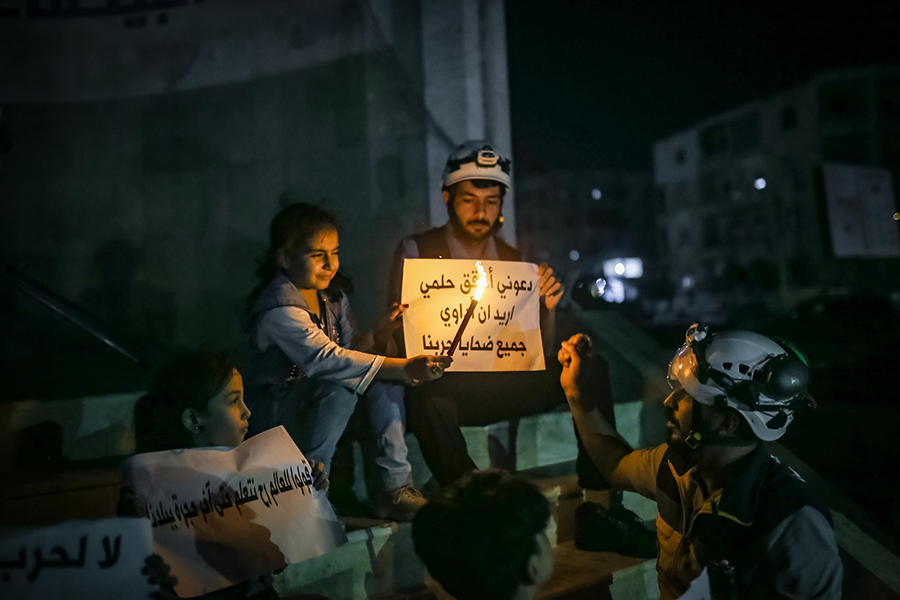 The other thing is that the OPCW is a treaty-based international organization. It is a political organization, not a court of law or a military alliance. It is not fair to expect them to do things that legitimately fall in the domain of other types of institutions. What the OPCW can do, and I would agree with you that deterrence is important, is the OPCW can extract a political price for using chemical weapons. A violator of the norm against the use of chemical weapons will not be treated as a normal country. People will know that you are not a normal country, that you used chemical weapons. In fact, at an OPCW Conference of the States Parties meeting in 2021, it was determined that Syria would be stripped of certain rights and privileges at the OPCW, such as the right to vote and the right to hold office until it fulfills its obligations. Now you might say, well, President [Bashar] Assad probably isn’t up at night worrying about whether or not he has an OPCW vote or Syria holds an office at the OPCW. But there is a broader strategy here, and the broader strategy is to isolate the Syrian regime, delegitimize them, and not have them treated as a normal country.
The other thing is that the OPCW is a treaty-based international organization. It is a political organization, not a court of law or a military alliance. It is not fair to expect them to do things that legitimately fall in the domain of other types of institutions. What the OPCW can do, and I would agree with you that deterrence is important, is the OPCW can extract a political price for using chemical weapons. A violator of the norm against the use of chemical weapons will not be treated as a normal country. People will know that you are not a normal country, that you used chemical weapons. In fact, at an OPCW Conference of the States Parties meeting in 2021, it was determined that Syria would be stripped of certain rights and privileges at the OPCW, such as the right to vote and the right to hold office until it fulfills its obligations. Now you might say, well, President [Bashar] Assad probably isn’t up at night worrying about whether or not he has an OPCW vote or Syria holds an office at the OPCW. But there is a broader strategy here, and the broader strategy is to isolate the Syrian regime, delegitimize them, and not have them treated as a normal country.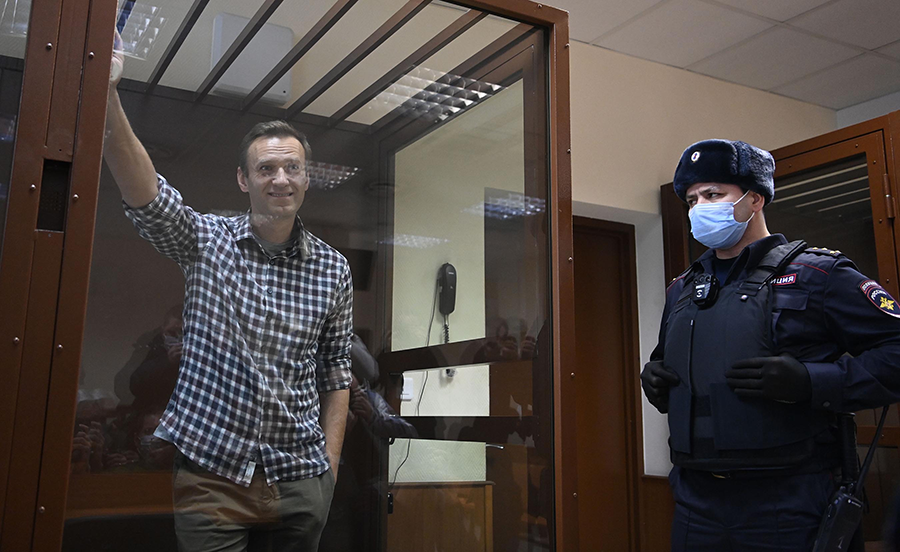 Manso: I would say that Russia is not in compliance with its obligations under the CWC, and I would very much agree that the evidence points to Russia having used a chemical agent in its attempted assassination of Navalny and also for the acts [against the Skripals] on UK soil. But I have two other points. One, it is only a very small number of countries that are willing to use chemical weapons. You have Syria and Russia. North Korea probably was also involved in an incident, but they’re not a member to the CWC. So, of the countries in the CWC that have used chemical weapons, it’s essentially Russia and Syria. As I said, they deny it. So, they feel the need to try to cover their tracks; Bellingcat has done a great job of uncovering those tracks.
Manso: I would say that Russia is not in compliance with its obligations under the CWC, and I would very much agree that the evidence points to Russia having used a chemical agent in its attempted assassination of Navalny and also for the acts [against the Skripals] on UK soil. But I have two other points. One, it is only a very small number of countries that are willing to use chemical weapons. You have Syria and Russia. North Korea probably was also involved in an incident, but they’re not a member to the CWC. So, of the countries in the CWC that have used chemical weapons, it’s essentially Russia and Syria. As I said, they deny it. So, they feel the need to try to cover their tracks; Bellingcat has done a great job of uncovering those tracks. After graduating from Mount Holyoke College in 1960, Catherine spent a year at the Free University of Berlin as a scholar in the Fulbright Program, studying East-West relations during one of the worst crises of the Cold War. That galvanized her determination to earn a doctorate in political science from the Massachusetts Institute of Technology, where she became one of the first three women in the United States to get a doctorate in security studies. Catherine spent the rest of her career trying to prevent nuclear war, make Europe more peaceful and secure, increase East-West understanding, and help other women make their own mark on the field.
After graduating from Mount Holyoke College in 1960, Catherine spent a year at the Free University of Berlin as a scholar in the Fulbright Program, studying East-West relations during one of the worst crises of the Cold War. That galvanized her determination to earn a doctorate in political science from the Massachusetts Institute of Technology, where she became one of the first three women in the United States to get a doctorate in security studies. Catherine spent the rest of her career trying to prevent nuclear war, make Europe more peaceful and secure, increase East-West understanding, and help other women make their own mark on the field.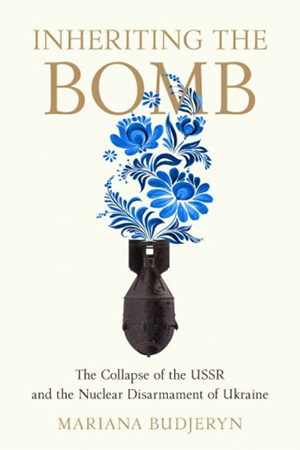
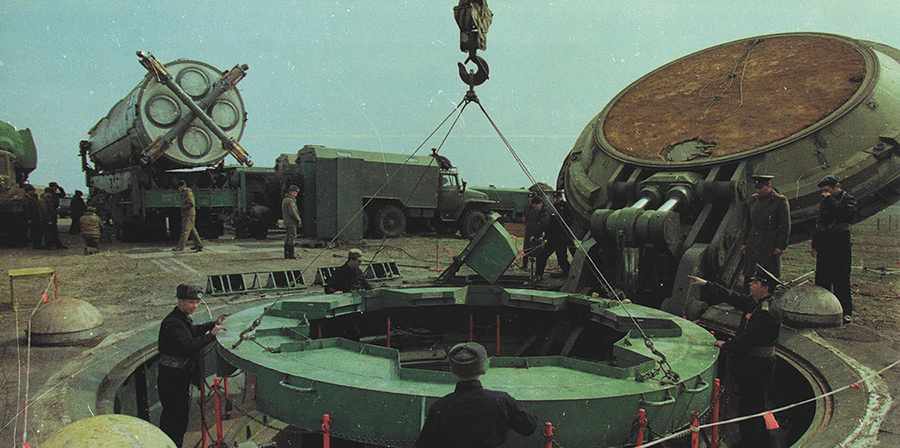 Ukraine’s nuclear disarmament was neither utopian naïveté nor enlightenment, but rather an imperative of independence. Moscow exercised direct control over nuclear weapons throughout the Soviet Union by means of rigidly centralized weapons command structures that were an obstacle to local self-determination. From the perspective of Ukrainians under Soviet rule, “[T]here were nuclear weapons in Ukraine and at the same time it was as if there were none” because these weapons were managed entirely by Moscow. The Soviet Union’s “armed forces, its enormous nuclear arsenal, and its military-industrial complex now stood, largely intact, resembling an exoskeleton from which the political body had suddenly slipped out,” Budjeryn recalls. Moscow continued to exploit local unfamiliarity with the nuclear weapons operations to avoid sharing control of the nuclear weapons in Ukraine. As Russian President Boris Yeltsin explained, “[T]hey don’t know how things work.” Even the reconstruction of the Commonwealth of Independent States strategic forces excluded the republics from nuclear decision-making.
Ukraine’s nuclear disarmament was neither utopian naïveté nor enlightenment, but rather an imperative of independence. Moscow exercised direct control over nuclear weapons throughout the Soviet Union by means of rigidly centralized weapons command structures that were an obstacle to local self-determination. From the perspective of Ukrainians under Soviet rule, “[T]here were nuclear weapons in Ukraine and at the same time it was as if there were none” because these weapons were managed entirely by Moscow. The Soviet Union’s “armed forces, its enormous nuclear arsenal, and its military-industrial complex now stood, largely intact, resembling an exoskeleton from which the political body had suddenly slipped out,” Budjeryn recalls. Moscow continued to exploit local unfamiliarity with the nuclear weapons operations to avoid sharing control of the nuclear weapons in Ukraine. As Russian President Boris Yeltsin explained, “[T]hey don’t know how things work.” Even the reconstruction of the Commonwealth of Independent States strategic forces excluded the republics from nuclear decision-making.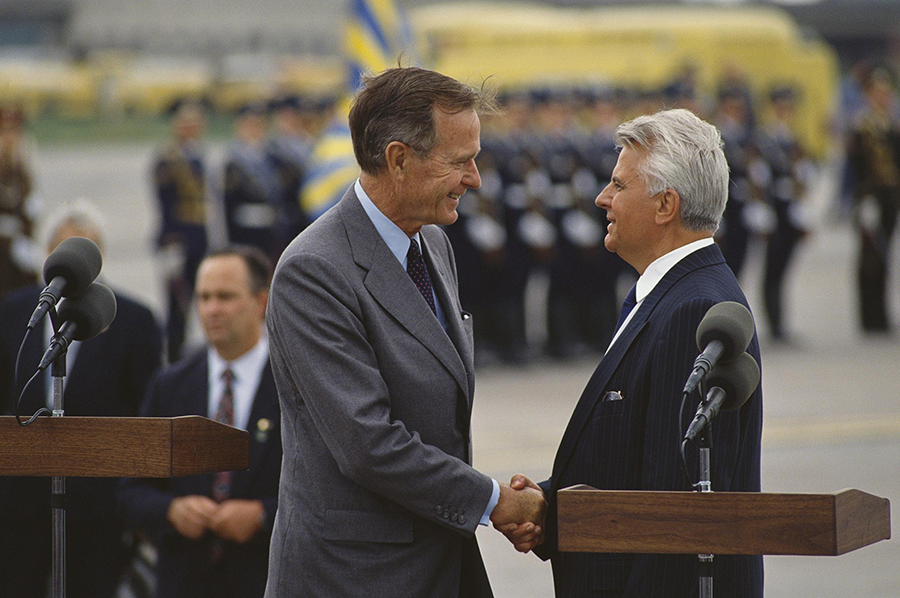 Washington’s bold intervention, however, remained cautious with regard to regional politics. Budjeryn recalls that “Washington preferred to ‘deal with the devil we know’ in Moscow, and was slow to develop relationships in the new independent states.” When Jack Matlock, U.S. ambassador to the Soviet Union, advised that the United States should open diplomatic posts in Soviet cities outside Moscow, President George H.W. Bush asked, “[F]or what?” Ukraine soon realized that nuclear weapons were the only leverage it had to bolster its security.
Washington’s bold intervention, however, remained cautious with regard to regional politics. Budjeryn recalls that “Washington preferred to ‘deal with the devil we know’ in Moscow, and was slow to develop relationships in the new independent states.” When Jack Matlock, U.S. ambassador to the Soviet Union, advised that the United States should open diplomatic posts in Soviet cities outside Moscow, President George H.W. Bush asked, “[F]or what?” Ukraine soon realized that nuclear weapons were the only leverage it had to bolster its security.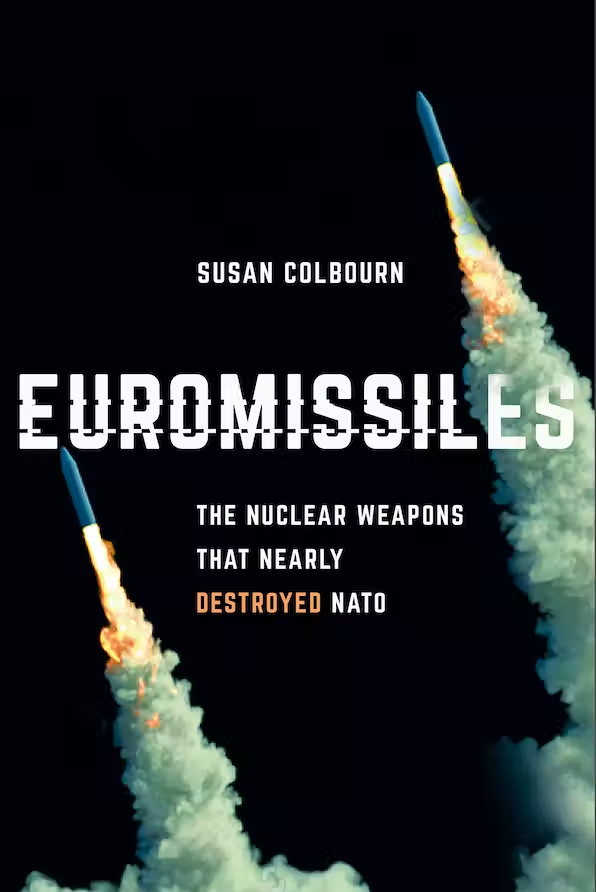 Euromissiles: The Nuclear Weapons That Nearly Destroyed NATO
Euromissiles: The Nuclear Weapons That Nearly Destroyed NATO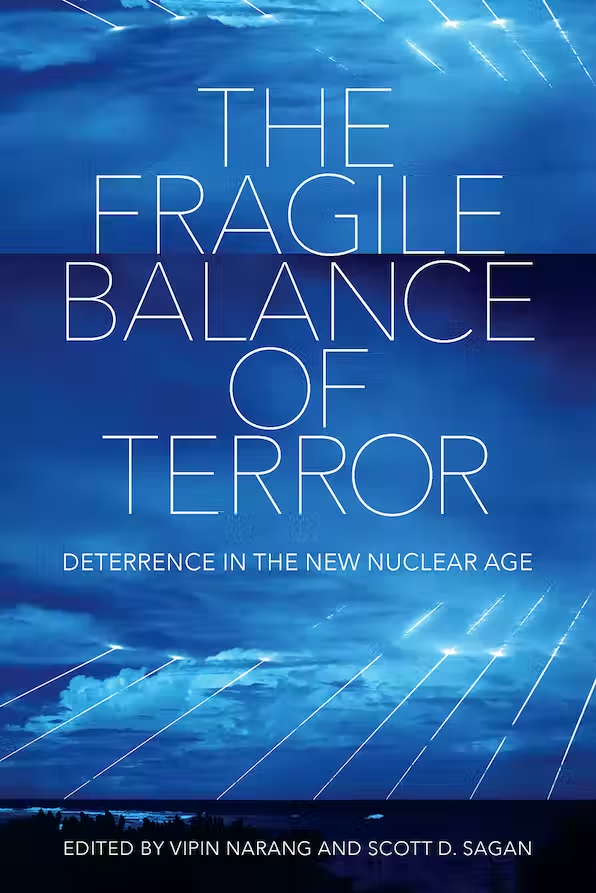 The Fragile Balance of Terror: Deterrence in the New Nuclear Age
The Fragile Balance of Terror: Deterrence in the New Nuclear Age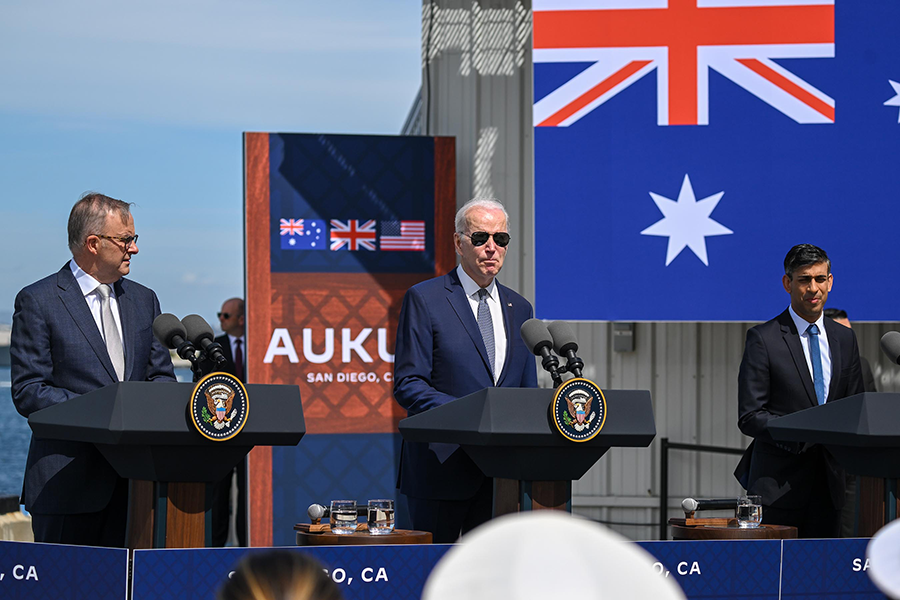 The March 13 announcement by Australian Prime Minister Anthony Albanese, U.S. President Joseph Biden, and UK Prime Minister Rishi Sunak comes 18 months after London and Washington revealed their intentions to provide Canberra with nuclear-powered submarines under the terms of the so-called AUKUS deal. (See
The March 13 announcement by Australian Prime Minister Anthony Albanese, U.S. President Joseph Biden, and UK Prime Minister Rishi Sunak comes 18 months after London and Washington revealed their intentions to provide Canberra with nuclear-powered submarines under the terms of the so-called AUKUS deal. (See 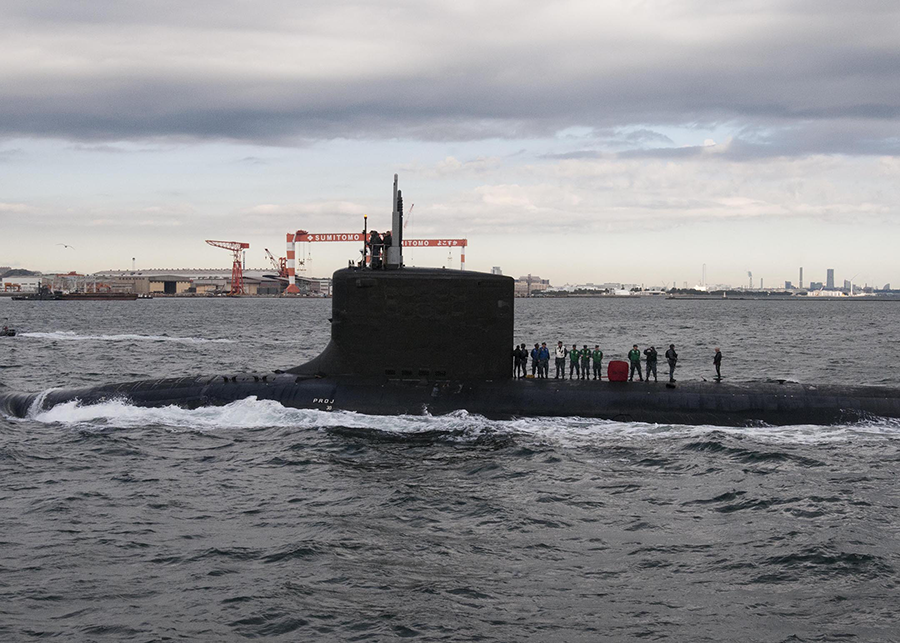 safeguarded, peaceful program for military purposes that do not involve the development of nuclear weapons, such as naval propulsion.
safeguarded, peaceful program for military purposes that do not involve the development of nuclear weapons, such as naval propulsion.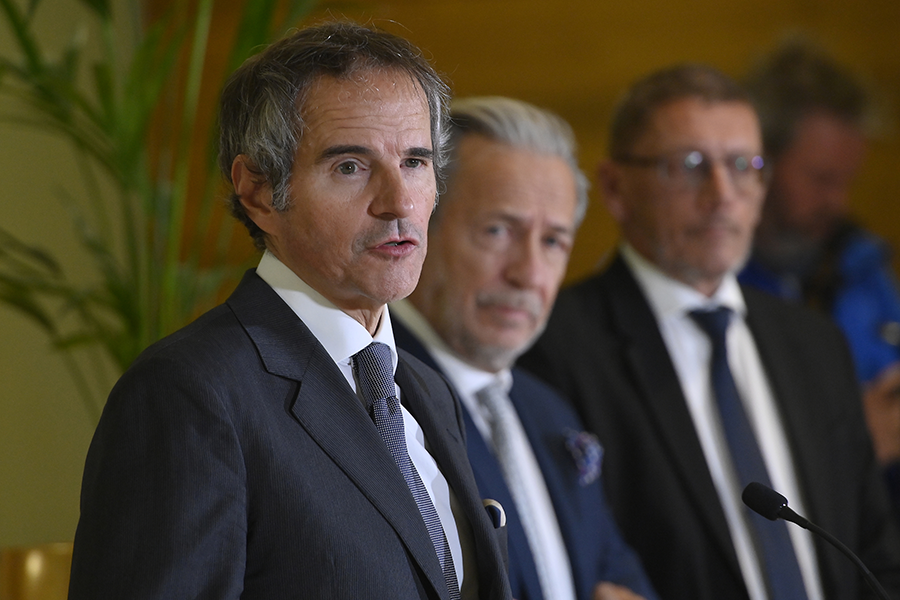 IAEA Director-General Rafael Mariano Grossi traveled to Tehran on March 3–4 to discuss agency concerns about safeguarding Iran’s nuclear program. In a March 4 statement, the IAEA and the Atomic Energy Organization of Iran (AEOI) announced that Tehran would “on a voluntary basis” allow the agency to “implement further appropriate verification and monitoring activities.”
IAEA Director-General Rafael Mariano Grossi traveled to Tehran on March 3–4 to discuss agency concerns about safeguarding Iran’s nuclear program. In a March 4 statement, the IAEA and the Atomic Energy Organization of Iran (AEOI) announced that Tehran would “on a voluntary basis” allow the agency to “implement further appropriate verification and monitoring activities.”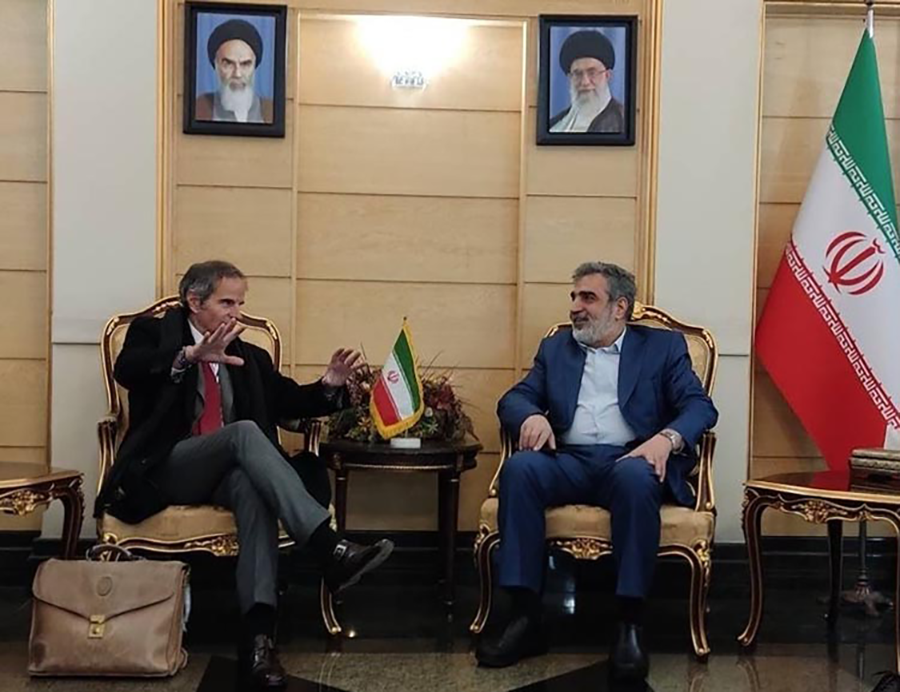 At the press conference, Grossi suggested that Iran agreed to reinstall surveillance equipment, including cameras and a monitor that tracked Iranian uranium enrichment in real time, that Tehran disconnected in June 2022. But Kamalvandi suggested that Iran will not install any new cameras or take steps contrary to a December 2020 nuclear law that required the AEOI to halt more intrusive access for inspectors and certain transparency measures specific to the 2015 Iran nuclear deal, formally known as the Joint Comprehensive Plan of Action (JCPOA).
At the press conference, Grossi suggested that Iran agreed to reinstall surveillance equipment, including cameras and a monitor that tracked Iranian uranium enrichment in real time, that Tehran disconnected in June 2022. But Kamalvandi suggested that Iran will not install any new cameras or take steps contrary to a December 2020 nuclear law that required the AEOI to halt more intrusive access for inspectors and certain transparency measures specific to the 2015 Iran nuclear deal, formally known as the Joint Comprehensive Plan of Action (JCPOA).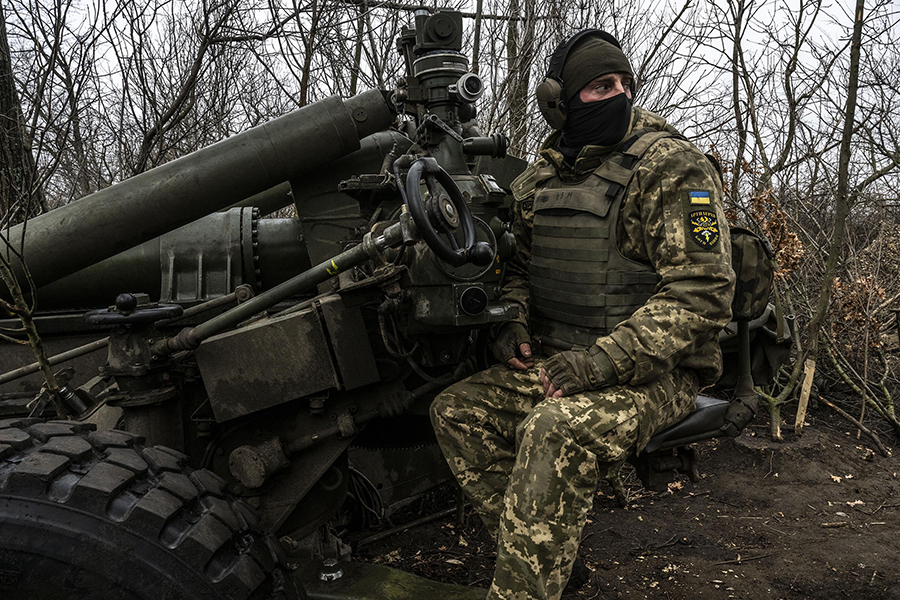 Although the report’s authors are cautious in predicting the future, their findings appear to show shifts in the global arms trade, in part driven by the war in Ukraine, that will result in more weapons flowing to Europe and a diminished role for Russia in the coming years.
Although the report’s authors are cautious in predicting the future, their findings appear to show shifts in the global arms trade, in part driven by the war in Ukraine, that will result in more weapons flowing to Europe and a diminished role for Russia in the coming years.